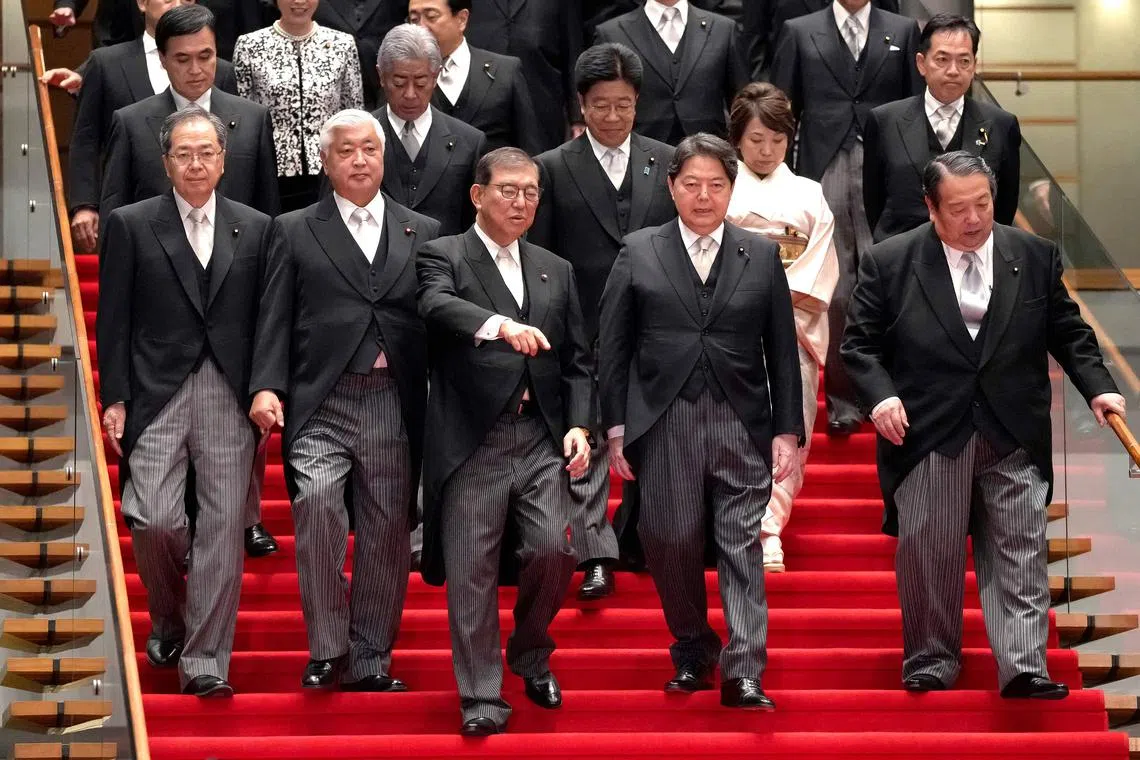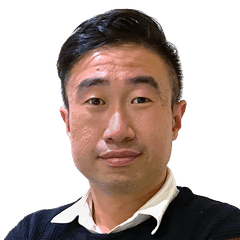News analysis
Japan PM Ishiba, once an outsider within LDP, forced to ditch idealism as leader
Sign up now: Get insights on Asia's fast-moving developments

Japanese Prime Minister Shigeru Ishiba (front row, centre) arriving for a photo session with his Cabinet members on Oct 1.
PHOTO: AFP
Follow topic:
TOKYO – Japan’s newly minted Prime Minister Shigeru Ishiba, once a gadfly described as an “opposition” even within the ruling Liberal Democratic Party (LDP) for his criticisms of the late former prime minister Shinzo Abe, promised to mend fences across faction lines after a bruising party leadership contest.
But observers said his picks for the Cabinet and party leadership positions exposed his weakness within the party, tellingly with the inclusion of a man who once labelled Mr Abe a “traitor” and boycotted his state funeral.
Mr Ishiba’s policy positions that had once been laden with ideals, meanwhile, will likely be watered down if his remarks since being elected as LDP chief on Sept 27 are anything to go by.
Among other things, he had advocated for an Asian version of the North Atlantic Treaty Organisation military alliance,
Now, he has even backed down from his clear antipathy towards a snap election, calling for one on Oct 27.
All this has resulted in negative media coverage for a prime minister who is only on Day Two of the job.
Bloomberg News snarkily pointed out in a column that Mr Ishiba has “barely the concept of a plan”, borrowing a phrase used by Donald Trump in the United States presidential race for which he has been mocked. The writer said: “Nailing down what Ishiba wants Japan to look like is more like nailing jelly to a wall.”
Domestic media was also unkind.
The left-leaning Asahi newspaper said Mr Ishiba’s “glaring inconsistency between his words and deeds has cost (him) dearly – he has lost the trust of the public, which was his most important asset”.
The usually pro-government Yomiuri newspaper warned of the clear risk that “the Ishiba administration will fall apart” if he fails to achieve harmony within the LDP.
Dr Mikitaka Masuyama, a political scientist at the National Graduate Institute for Policy Studies, told The Straits Times that the only thing that was clear at this stage was Mr Ishiba’s intent to make a clean break from Abe-era policies.
“It’s a symbolic selection of Cabinet ministers – Ishiba wouldn’t go overtly against Abe loyalists, but it is an indication of what he might do, which might be a significant departure from Abe policies,” he said.
In this regard, Mr Ishiba’s appointment of Mr Seiichiro Murakami in the key position of internal affairs and communications minister is telling: The 72-year-old 12-term lawmaker once criticised Mr Abe for having “wrecked fiscal health, the financial system, foreign diplomacy and bureaucratic structures”, and even labelled him a “traitor” after he was assassinated.
On Oct 1, Mr Murakami again blamed Mr Abe’s signature Abenomics policies of monetary easing, fiscal stimulus and structural reforms for creating “negative legacies” that have resulted in ongoing stock market volatility and the sharp depreciation of the yen.
Sophia University political scientist Koichi Nakano, while describing the Cabinet as a “serious change of guard”, noted: “Ishiba is relying on people who have long been marginalised, or who went through difficulties when the Abe faction was so dominant.”
This has caused disquiet within the LDP. Former economy minister Koichi Hagiuda, 61, an Abe loyalist, suggested there was a “bias towards friends” and said that Mr Ishiba had clearly gone against his predecessor Fumio Kishida’s hopes for a “dream team” to be created to lead Japan forward.
“I’m not saying that the people chosen weren’t the best fit for their positions,” he said. “But it would have been better if they were chosen more broadly across party faction lines.”
Mr Ishiba’s 20-member Cabinet,
The Cabinet is stacked with former defence ministers – there are more of them (four, including Mr Ishiba) than women (two). Critics say this contradicts Mr Ishiba’s own promises on Oct 1 to “honour the rights of women so that, in various sectors of society, women are able to participate”.
Mr Kishida’s Cabinet had five women.
The two female ministers in Mr Ishiba’s Cabinet
The four former defence ministers are Mr Ishiba, who held the role twice from 2002 to 2004 and 2007 to 2008; Mr Gen Nakatani, who returns as defence chief for the third time having also held the portfolio from 2001 to 2002 and 2014 to 2016; Foreign Minister Takeshi Iwaya, 67, who was defence minister from 2018 to 2019, and chief Cabinet secretary Yoshimasa Hayashi, 63, who was defence minister in 2008.
What this shows, experts said, is that Mr Ishiba has few friends within the LDP, buoyed to victory by sheer circumstance and backroom wheeling and dealing to keep his staunch conservative rival Sanae Takaichi, 63, out of power.
“His narrow support base explains why he had to move back from many of his initial idealistic proposals,” said political scientist Toru Yoshida of Doshisha University, noting that Mr Ishiba had to tread the middle ground to survive.
Dr Masuyama added: “Ishiba, as a vocal critic, was in no position to influence actual policy. But now that he is in the driving seat, he is heavily constrained by reality... I don’t think he has any specific ideas about ageing or healthcare or social security issues.”
Notably, Mr Ishiba on Sept 27 admitted to his own shortcomings on economic and fiscal policy.
On Oct 1, he said he would inherit the path charted out by Mr Kishida – promising to deepen the security alliance with the US, “normalise” monetary policy, as well as promote the use of nuclear power and the adoption of “My Number” digital identities.
Regarding the economy, he further vowed to accelerate the shift from savings to investments as promoted by Mr Kishida, and to continue promoting an investment-friendly climate to “make Japan an investment superpower”.
He also spoke about accelerating wage growth by increasing average minimum wages to at least 1,500 yen (S$13.40) per hour by 2029, up from the current 1,054 yen per hour, although this was thin on specifics.
Business leaders, including from the powerful Keidanren lobby and the Japan Association of Corporate Executives, applauded Mr Ishiba, urging him to implement necessary measures to achieve “a virtuous circle of growth and redistribution” and break Japan out of its deflationary mindset.
These were, notably, key planks of Mr Kishida’s signature “new form of capitalism” policy.
Meanwhile, Mr Ishiba said that the political slush fund scandal, which implicated nearly one in five LDP lawmakers and derailed Mr Kishida’s leadership, would not be pursued further in the absence of new evidence.
Experts said this could negatively impact Mr Ishiba’s public support, given that he has long not shied away from speaking truth to power and echoed the public’s demands for full accountability.
But the pragmatic need to tiptoe around political minefields has clipped Mr Ishiba’s wings, and it remains to be seen if he can claw back public trust ahead of the general election.
“It could just be a very uninspiring race to the bottom, with low interest and turnout,” said Dr Nakano, now a visiting scholar at the Weatherhead programme on US-Japan relations at Harvard University, noting that the opposition remains disjointed as well.
Going forward, all eyes will be on Mr Ishiba’s policy speech to the Diet on Oct 4, which is likely to serve as an election speech, given that it is the first time he will properly spell out his priorities as prime minister.
He is expected to visit the disaster-stricken Noto Peninsula on Oct 5, before returning to Tokyo for Diet debates ahead of the Lower House’s dissolution on Oct 9.
Mr Ishiba will then travel to Laos for the Asean Summit in his first overseas engagement as PM, before Nomination Day on Oct 15 for the Oct 27 snap election.


